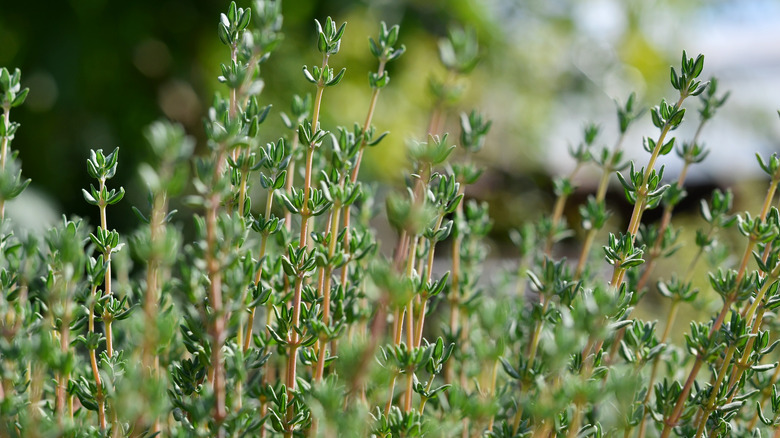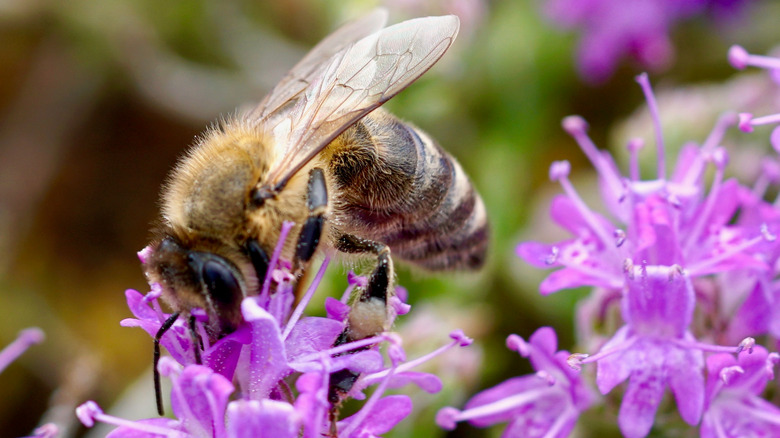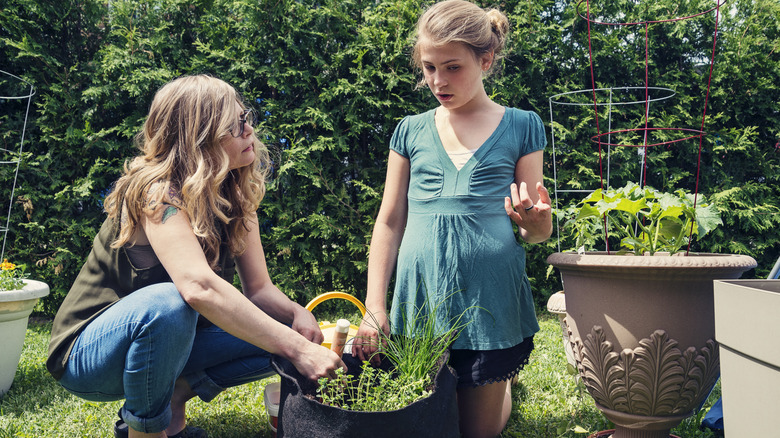Attract Bees To Your Garden By Planting Thyme
You can do quite a bit to support the growth of your garden, including providing the right amount of water and fertilizing the soil. Yet, bees are one of the most important parts of a successful harvest because of their ability to pollinate plants, encouraging the production of veggies. To get bees to visit and spend some time pollinating your garden, plant what attracts them, including herbs like thyme. Once there, bees are likely to help with the rest of your plants.
Bees of all types can be very good for your garden, especially honeybees. These hard-working insects are critical to the production of food, but there are far fewer bees now than there used to be. That means you may have to work a bit harder to get them to visit your garden. The best way to do that is to provide specific foods that attract them. Having an herb garden creates an easy-to-access source of nectar for bees and typically draws them in. Thyme is one option, though others include chives, fennel, and lavender. You'll benefit by having a few tips to help you with planting an herb garden.
There are lots of benefits to growing thyme in your garden
Thyme is a fantastic herb with a somewhat strong bite and a floral hint. It's easy enough to put a few sprigs into your roast or to use it to flavor vegetables in a slow-cooked meal. There are other reasons to grow it, though. First, it brings in the honey bees, as noted, but it also encourages other pollinators in your area. At the same time, it does an excellent job of keeping flea beetles and hornworms from invading your other plants.
This plant, which is available in several varieties, can be a nice ground cover, so even if you're not growing lots of plants but want to keep the pests away from your flowers, consider the addition of thyme. It does well in most conditions, including partial shade, which means you can easily use it in that shaded corner of your garden that doesn't get enough sunlight for other harvest-worthy plants. It's also the type of herb that doesn't need a lot of your attention or very much water (it can handle somewhat dry conditions). This low-maintenance plant is also a perennial, meaning if you plant it once and care for it well, it will continue to benefit your garden for years to come.
Creating bee success with thyme
To encourage success when growing thyme, there are a few tips to keep in mind. You can purchase seeds or thyme starters for your garden, but some of the best come from cuttings from mature plants already thriving in your area. If your neighbor has some, ask for a few seedlings for your garden. For thyme to grow, ensure the soil is loose and mounded to encourage proper water draining. Water-logged plants are not going to be as productive. You can grow thyme in containers if you don't have room within the garden itself.
Thyme typically grows low to the ground but creates woody, beautiful flowers when in bloom. This is what attracts the bees. It's a slow-growing herb, though, which means you may want to skip growing from seed (or have lots of patience with the process). For design purposes (and to attract as many pollinators as possible), place thyme along the edges of your garden, perhaps in a row about a foot or more apart. This will encourage bees in every direction.
Do you have a beehive producing honey on your property? If so, planting thyme will keep your honey bees close but also create a subtle flavor in the honey produced. That can make for an excellent honey to add to tea. Thyme is a simple way to attract honeybees to your garden without having to add a lot of work to the process of producing a unique, flavorful product.


